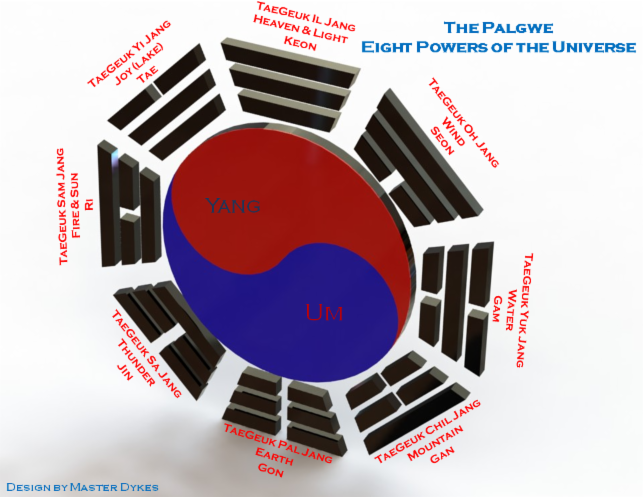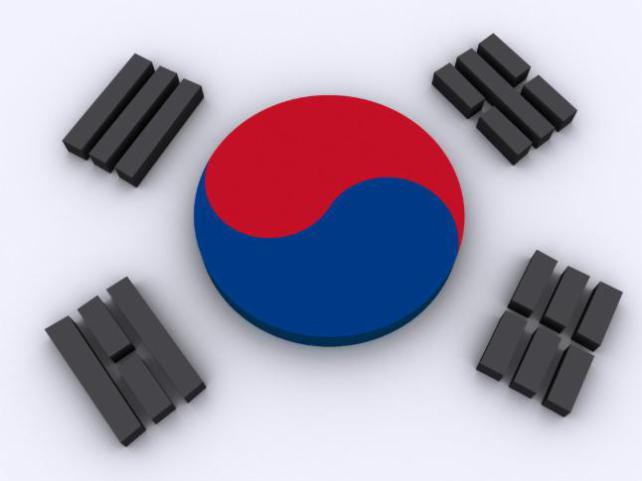Tenets of Tae Kwon Do
Courtesy
To be thoughtful and considerate of others.
Integrity
To be honest and good. To know right from wrong, and to always choose right. TKD students should live by a code of moral values, exercise humility and seek truth without judgment.
Perseverance
To never give up in the pursuit of one’s goals. TKD students should exercise patience and determination when pursuing their goals. They should accept each challenge and finish what they start.
Self-Control
Restraint exercised over one's own emotions, impulses or desires. In addition, it means to apply the proper amount of force in accordance with the situation.
Indomitable Spirit
To have courage in the face of adversity. TKD students should never be dominated by or have their spirit broken by another.
Six Ways of Turning During Fundamentals
1. When doing a single block, turn in to that block.
2. When doing a single hand strike, turn into a low block.
3. When doing a single kick, turn into the preparatory position for that kick.
4. When doing a combination that begins with a block, turn into the entire combination.
5. When doing a combination that begins with a hand strike, turn into a low block.
6. When doing a combination that begins with any kick, turn in to double forearm block.
Rules & Etiquette
Spectator Code of Conduct
Please note that these rules are in place to limit distraction of students in class that may lead to misinformation or injury. If you have any specific questions or concerns please see the head
instructor of the class.
Keep voices down to prevent distraction from class instruction.
Stand when asked and remain standing as the class salutes the flags and the instructors. (It is only mandatory for students to bow to the flags.)
Put cellular phones and pagers on vibrate to avoid unnecessary noise.
Please take all calls outside of the training area to be courteous of the students and instructors in class.
Remove shoes when walking on the training room floor.
Students should not be on the training floor unless they are in uniform or have been given permission from an instructor.
Parents, please be mindful of your children that are not participating in class. They should not be left unattended in the adjacent room, or the changing rooms downstairs.
Dress Code
Uniforms must be clean and wrinkle-free for every class.
Belts should be tied properly and remain on during class. Belts should never be washed or placed on the ground.
All female students are required to wear a t-shirt under their uniform that matches the dominating color of their belt, not their belt stripe.
Male students are authorized to wear a white t-shirt (short or long) under their uniform.
Black belt students are authorized to wear a white or black t-shirt (short or long) under their uniform.
Fingernails and toenails must be kept short and clean for the safety of yourself and others.
No jewelry may be worn in class. Glasses are permitted except for full-contact sparring in which the student should wear protective sport glasses or contact lenses. Exceptions are wedding bands (not
wedding rings however), medic-alert items and any other items which have received approval from the instructor. Starter earrings may be worn but tape must be put over them for safety.
Only approved Tae Kwon Do shoes may be worn on the training floor.
All students with long hair should have it pulled back for safety and comfort.
Dojang Etiquette
Bow when entering the training mat and exiting the mat. This means from the spectator area, the changing room or any other area in which you enter or exit the mat.
If class has begun and you are tardy, do not run onto the mat. Wait at the edge, so the instructor can safely have you line up.
Students line up by rank. The highest rank is at the far end, adults always before children. If the rank is the same, you line up by who tested first, and if the same then by age.
Clap your hands to get the attention of spectators, say “spectators please stand” then “cheryut”, “to the flags dora”, “Kyung yea”. Then “to the instructors, dora, kyung yea”.
If you must leave early please let an instructor know before class.
Students should address others with Sir and Maam, and are expected to do this outside of the dojang.
Students should learn the 3 proper ways to sit on the mat during class. Each position is designed to encourage good posture. No leaning on the walls!
Street shoes are to be placed on the shoe rack and not taken into the changing rooms.
Do not ask to test. Students are guided by the requirement sheets posted, but it is up to the instructor to determine their level of readiness. Students should not learn requirements past their rank,
rather they should focus on truly understanding what is expected of them at the rank they hold.
Adjust your dobok and belt with your back to the flags and the instructor.
Only Master Dykes can introduce students to their new poomse.
Consider the dojang your home and treat it as such. Take care of equipment, restrooms, locker rooms and the training floor. Put things back in their proper place and report any problems to the
instructor in charge. The dojang is a place where “the way” of Tae Kwon Do is taught. Please be respectful at all times. It is a place to learn and make friends. Members learn from their experiences
both in and out of the school. You should be proud of this and this pride is reflected in your behavior both on the floor and outside the school.
South Korean Flag
The flag, called "Taekukki," symbolizes the thought, philosophy, and mysticism of the Far East.
The circle in the center, red (hong) upper half and blue (chung) lower half, represents absolute, or the essential unity of all being. The Yang (positive) and the Um (negative) are divisions within
the circle that represent duality. Examples of duality are heaven and hell, fire and water, life and death, good and evil, or night and day.
The four trigrams (kwae) also indicate the duality of opposites and balances. In the upper left trigram, three unbroken lines symbolize Heaven; opposite them in the lower right, three broken lines
represent Earth. In the upper right trigram, two broken lines separated by an unbroken line is the symbol of Water; opposite them is Fire, symbolized by two unbroken lines separated by a broken
line.
The white background of the flag represents the "land". The circle represents the "people". The four trigrams symbolize the "government". All three make up the essential elements of the nation.
Fundamental Knowledge
Korean Terminology
Poomse
Taegeuk Il Jang
Taegeuk Yi Jang
Taegeuk Sam Jang
Taegeuk Sa Jang
Taegeuk Oh Jang
Taegeuk Yuk Jang
Taegeuk Chil Jang
Taegeuk Pal Jang
Portfolio Items
All students must maintain a portfolio of their Tae Kwon Do career in accordance with the requirements for their belt rank. This portfolio will be submitted for review when the student is
evaluated for 1st geup. The portfolio will be returned to the student for corrections and the final product will be submitted at the pre-test for black belt. The forms below must be included in the
portfolio along with the pertinent information that each document requires.
Competition Log
Community Service Log
Demonstration Log
Special Events Log
Instructing Hours Log
CommunityServiceLogSheet1
CommunityServiceLogSheet1.pdf
Adobe Acrobat document [42.4 KB]
Newsletters
OCT 2011 Newsletter
NOV 2011 Newsletter
DEC 2011 Newsletter
JAN 2012 Newsletter
FEB 2012 Newsletter
MAR 2012 Newsletter
APR 2012 Newsletter
MAY2012 Newsletter
SEP2014 Newsletter
Tournament Information
March 11, 2017 Great Lakes Cup, Lansing, MI
April 8, 2017 USAT Michigan State Championships, Fowlerville, MI
April 29, 2017 USA Championships, Kalamazoo, MI
May 20, 2017 Eric Rose Memorial Championships, Taylor, MI
June 29-July 6, 2017 USAT National Championships, Detroit, MI
Milan TKD in the News
Milan Eagle News Artice NOV2012
Milan Heritage Article JAN2013
7 East Main Street, Milan, MI 48160 734-439-KICK (5425)
Tae+Kwon+Do+Students+Earn+First
Tae+Kwon+Do+Students+Earn+First.pdf
Adobe Acrobat document [84.6 KB]
Milan+Eagle+News+Article+NOV2012
Milan+Eagle+News+Article+NOV2012.pdf
Adobe Acrobat document [194.2 KB]
Milan+Heritage+Article+JAN2013
Milan+Heritage+Article+JAN2013.pdf
Adobe Acrobat document [27.4 KB]



